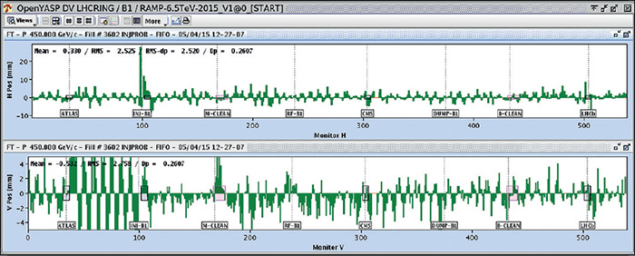
After two years of intense maintenance and consolidation, and several months of preparation for the restart, the LHC is back in operation. At 10.41 a.m. on 5 April, for the first time in more than two years, proton Beam 1 completed an anti-clockwise circuit of the 27-km ring at the injection energy of 450 GeV. Injected at point 8 on the LHC, Beam 1 was allowed round the ring one step at a time, as collimators were opened at each point in turn, once the operators had checked that all was working well. On the way, the protons provided the first “beam-splash” events for the ATLAS and CMS experiments, at points 1 and 5, respectively. Beam 2 then followed a similar procedure. Injected at point 2, it completed its first orbit in the clockwise direction at 12.27 p.m.
The sight of first beam has set the LHC on course for Run 2 – but not without the kind of challenge to be expected when restarting such a complex system after the work undertaken during the long shutdown. The Herculean task to prepare the machine for operation at 6.5 TeV per beam – almost double the energy of Run 1 – involved the consolidation of some 10,000 electrical interconnections between the magnets, the addition of further magnet-protection systems, and the improvement and strengthening of cryogenic, vacuum and electronic systems.
Following the successful injection tests on 7–8 March, the final training of the superconducting magnets to the current levels required for a beam energy of 6.5 TeV continued in parallel with the many steps required for the machine check-out. During this final phase before beam, the various LHC systems are put through their operational paces from the CERN Control Centre. These include important tests of the beam-dump beam-interlock systems. All of the magnetic circuits are driven through the ramp, squeeze, ramp-down, and pre-cycle steps, together with the collimators and RF. Instrumentation, feedbacks, and the control system are also stress-tested.

By mid-March, the powering tests had left all but two of the 1700 or so magnetic circuits fully qualified for 6.5 TeV – the result of a six-month-long programme of rigorous tests involving the quench-protection system, power converters, energy extraction, uninterruptible power supplies, interlocks, electrical quality assurance and magnet behaviour. The dipoles of sector 4-5 proved a little stubborn but reached the target value of 11,080 A – the value for 6.5 TeV with a margin of an additional 100 A – after some 50 training quenches. Sector 3-4 was also nearly fully trained to the same value, when an earth fault occurred in the early morning of 21 March.
Investigations eventually pinned down the fault to a metal fragment lodged in a box housing a high-current bypass diode. After intensive discussions and simulations, the accelerator team decided to melt the fragment, and on 30 March injected a current of almost 400 A into the diode circuit for just a few milliseconds. Measurements made the following day confirmed that the short-circuit had indeed disappeared. Teams then had to re-qualify the sector, testing all of the circuits, particularly the dipole circuit that carries current up to 11 kA, before training could begin again. By 2 April, sector 3-4 had finally reached the target for operation at 6.5 TeV, and preparations to close the LHC for beam were fully under way again, for the successful restart three days later.
• To find out more, see the LHC reports in CERN Bulletin: bulletin.cern.ch.





